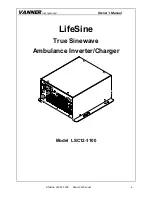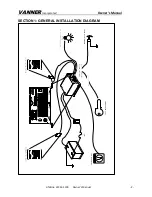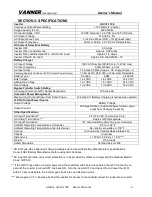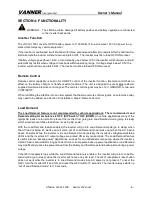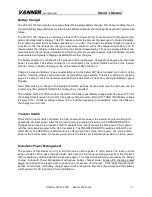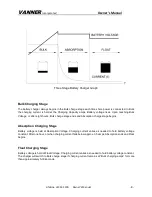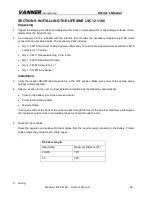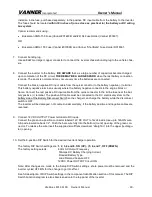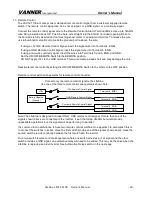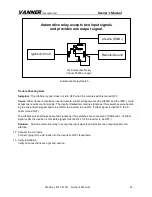
VANNER
Incorporated
Owner’s Manual
LifeSine LSC12-1100 Owner’s Manual - 6 -
SECTION 4: FUNCTIONALITY
WARNING : The LifeSine will be damaged if battery positive and battery negative are connected
to the inverter backwards.
Inverter Function
The LSC12-1100 converts 12VDC battery power to 1100 Watts of true sine wave 120V AC power to op-
erate vital emergency vehicle equipment.
If the inverter is overloaded it will shut down for three seconds and attempt to restart. After 5 shutdown/re-
start attempts the inverter will shut down and latch OFF. The inverter must be turned OFF/ON to reset.
If battery voltage goes above 16.5V, or momentarily goes below 10.5V the inverter will shut down and will
automatically restart when voltage comes back within operating range. If voltage stays below 10.5V the
inverter will shut down and latch OFF. The inverter must be turned OFF/ON to reset.
Remote Control
Remote control capability is built in for ON/OFF control of the inverter function. (Remote control has no
effect on the battery charger or transfer switch functions.) The unit is designed to accept
one
customer
supplied maintained remote control signal. The remote control signal may be +12V, GROUND, or two-wire
CONTINUITY.
When retrofitting the LifeSine into an older system that has two remote control signals, an automotive relay
may need to be added. see Section 8: Installation; Step 9: Remote Control.
Load Demand
The Load Demand feature is not recommended for vehicle applications. The recommended Load
Demand setting for ambulance is OFF. (DIP Switch 7 OFF (DOWN.)
In vehicle applications many of the
typical AC loads are too small to prevent the inverter from going into Load Demand mode (going to sleep)
which would prevent those loads from receiving AC power.
With the Load Demand feature enabled, the inverter will go into Load Demand mode (go to sleep) when
the AC load is below 20 watts and will come out of Load Demand mode (wake up) when the AC load is
above 40 watts. While the inverter is in Load Demand mode (asleep) the inverter’s voltage/power/status
LED’s and the inverter’s AC output voltage are pulsed ON every ten seconds. The Load Demand feature
is useful in some “backup power” applications, such as for an unattended sump pump, where the inverter’s
total AC load is zero watts for long periods of time. In sump pump back-up power applications Load Demand
may significantly reduce the power drawn from the battery and therefore extend backup time during a power
outage.
If the GFCI receptacle trips while the Load Demand feature is enabled, the inverter will go into Load De-
mand mode (go to sleep) since the inverter will not see any AC load. The GFCI receptacle’s reset button
does not work while the inverter is in Load Demand mode since AC power is not present. To reset the
GFCI, turn the inverter OFF and ON, and reset the GFCI within 10 seconds. The inverter always starts up
“out of Load Demand mode” for 10 seconds.

